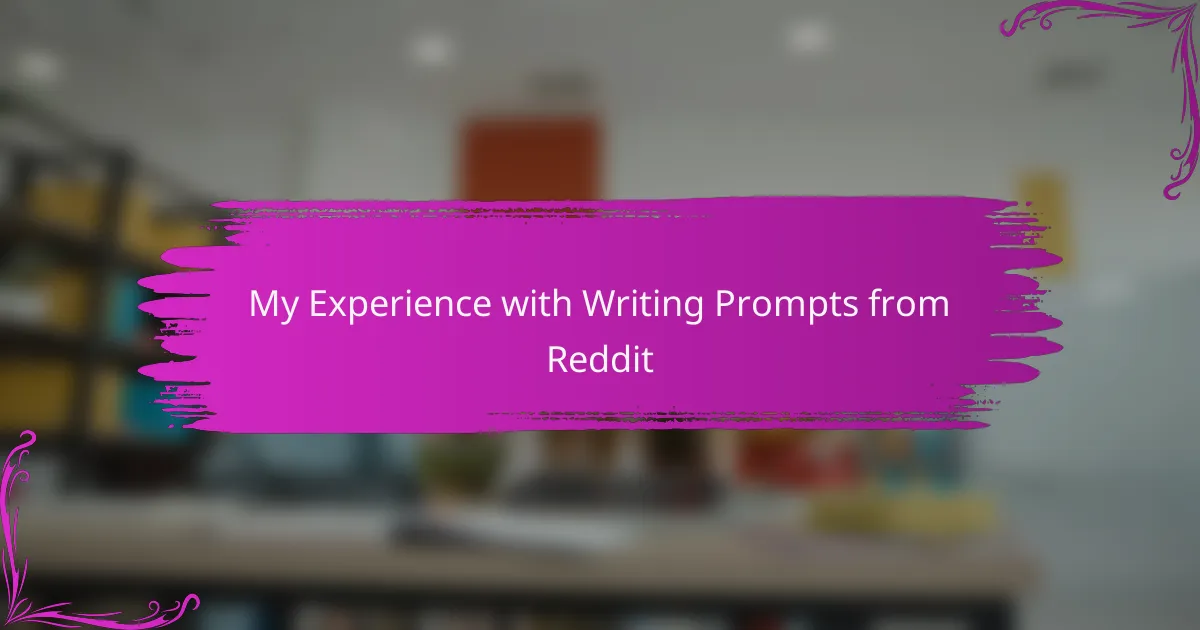Key takeaways
- Scrivener’s versatility supports various writing projects like novels, theses, and screenplays, enhancing overall productivity.
- Key features such as the Corkboard View, Binder, and Research Storage facilitate organization and streamline the writing process.
- Setting writing goals within Scrivener encourages consistent progress and boosts motivation during writing sessions.
- Utilizing templates and dedicated folders aids in managing project complexity, making it easier for writers to stay focused and structured.
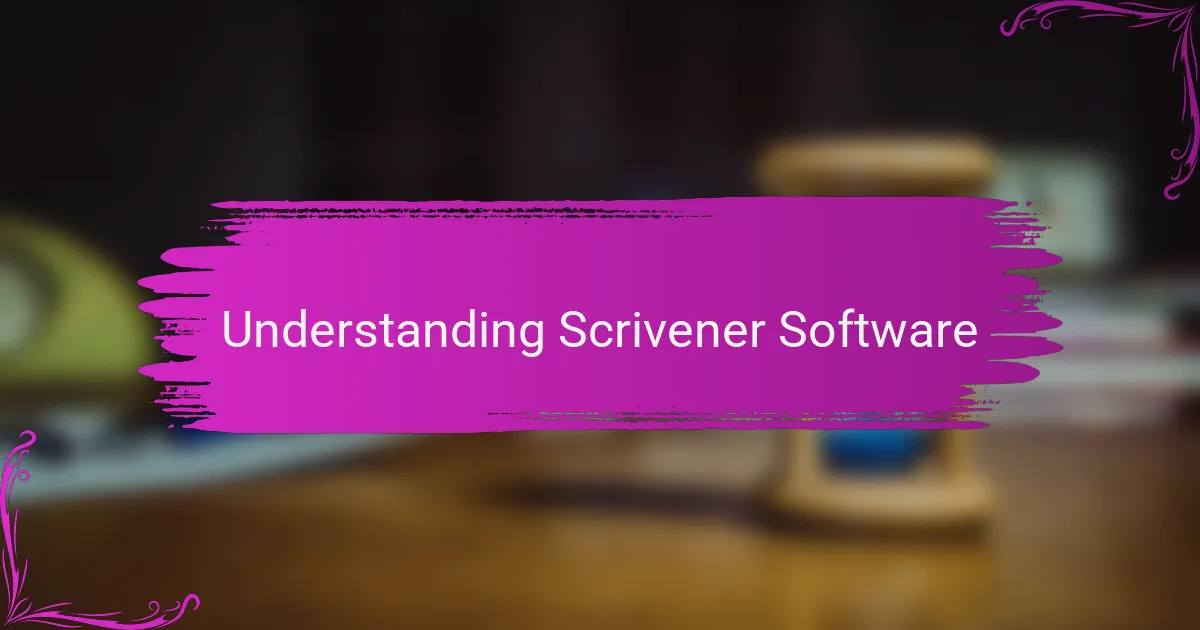
Understanding Scrivener Software
Scrivener is a powerful tool that I’ve grown to appreciate over time. When I first started using it, I was overwhelmed by its many features. Each function and button felt intimidating, but once I took the time to understand the software, it transformed my writing process. Its ability to organize notes, research, and drafts all in one place was a game changer for me.
One of the main strengths of Scrivener lies in its versatility. Whether you’re working on a novel, thesis, or screenplay, the software adapts to your needs. I particularly love how I can switch easily between different views, like the corkboard and outline options. It feels like I’m holding my entire project in my hands, allowing me to visualize my work in ways that paper alone never could.
Here are some key features that make Scrivener effective for writers:
– Corkboard View: Helps visualize and rearrange your ideas easily.
– Binder: Organizes your entire project with sections and notes at a glance.
– Customizable Templates: Offers various formats such as screenplays or non-fiction layouts.
– Split View: Allows you to work on multiple sections simultaneously, perfect for comparing and writing.
– Research Storage: Keep all your materials, like images and PDFs, in one accessible place.
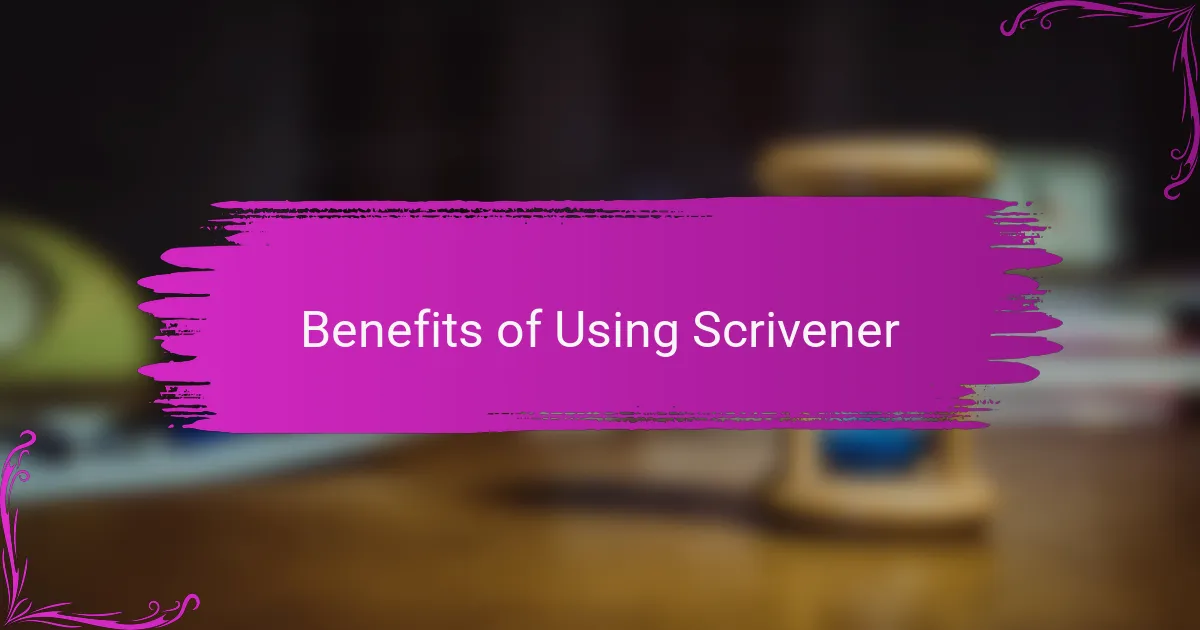
Benefits of Using Scrivener
Using Scrivener has transformed the way I approach writing projects. The ability to organize my thoughts and ideas into distinct sections allows for a clearer vision of my work. I remember the first time I saw my chaotic notes take shape into a structured outline; it was a palpable relief that helped me dive into writing with a renewed focus.
One of the most significant benefits of Scrivener is its versatility. It caters to various writing styles, whether you’re drafting a novel, a research paper, or even a screenplay. This adaptability ensures that it can meet the needs of any writer and enhance productivity.
Benefits of Using Scrivener:
– Organization: Easily create folders for chapters, scenes, and research to keep everything in one place.
– Corkboard Feature: Visually arrange and rearrange plot points or chapter outlines for better flow.
– Customizable Templates: Access templates tailored for different genres and writing formats.
– Distraction-Free Writing Mode: Focus on writing without the clutter of menus and options.
– Research Integration: Import notes, articles, and images directly into your project for quick reference.
I find that these features not only streamline my writing process but also spark my creativity, making Scrivener an invaluable tool in my literary journey.

Key Features of Scrivener
The Corkboard View is one of my absolute favorites in Scrivener. I remember feeling like I was juggling a hundred ideas at once, but this feature lets me visually arrange my thoughts like cards on a board. It makes it so easy to see how everything fits together, and there’s something satisfying about dragging a note to a different spot and watching my narrative evolve.
Then there’s the Binder, which I initially underestimated. Having everything organized at a glance is one of those “why didn’t I think of this before?” moments. I love how I can create folders for chapters and sections, keeping my notes, drafts, and research neatly out of the way yet easily accessible. It’s like having my own personal library, tailored only to my writing project.
The Research Storage feature is another standout aspect. I’ve lost countless hours searching for sources or materials in the past, but with Scrivener, I keep everything in one place. I can drop in PDFs, images, and even web links right into my project. Honestly, it feels liberating not to leave the writing interface to hunt down information. How much easier could your writing process be with that kind of access?
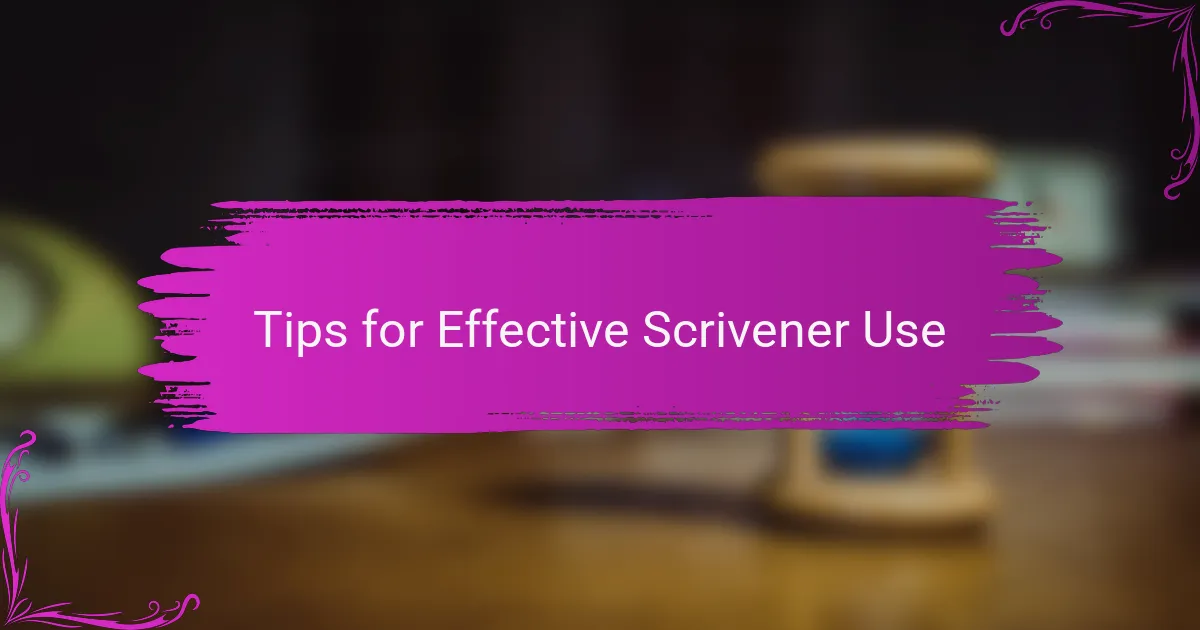
Tips for Effective Scrivener Use
Using Scrivener effectively is all about making the most of its unique features. Personally, I find the corkboard view invaluable for visualizing my projects. It allows me to arrange ideas like index cards, making it easier to see how everything connects.
To enhance your experience with Scrivener, consider these tips:
- Utilize Folders and Subfolders: Organize your work by separating chapters and scenes into folders, creating a clear structure.
- Take Advantage of the Inspector: Keep notes, keywords, and metadata handy with the Inspector feature to streamline your writing process.
- Set Writing Goals: Use the Project Targets feature to set daily word count goals, which keeps me motivated and focused.
- Leverage Templates: Explore the provided templates for different genres, saving time in project setup.
- Export Options: Familiarize yourself with various export formats to easily share your manuscript or collaborate with others.
By implementing these tips, I feel more productive and less overwhelmed, allowing my creativity to flourish while using Scrivener.
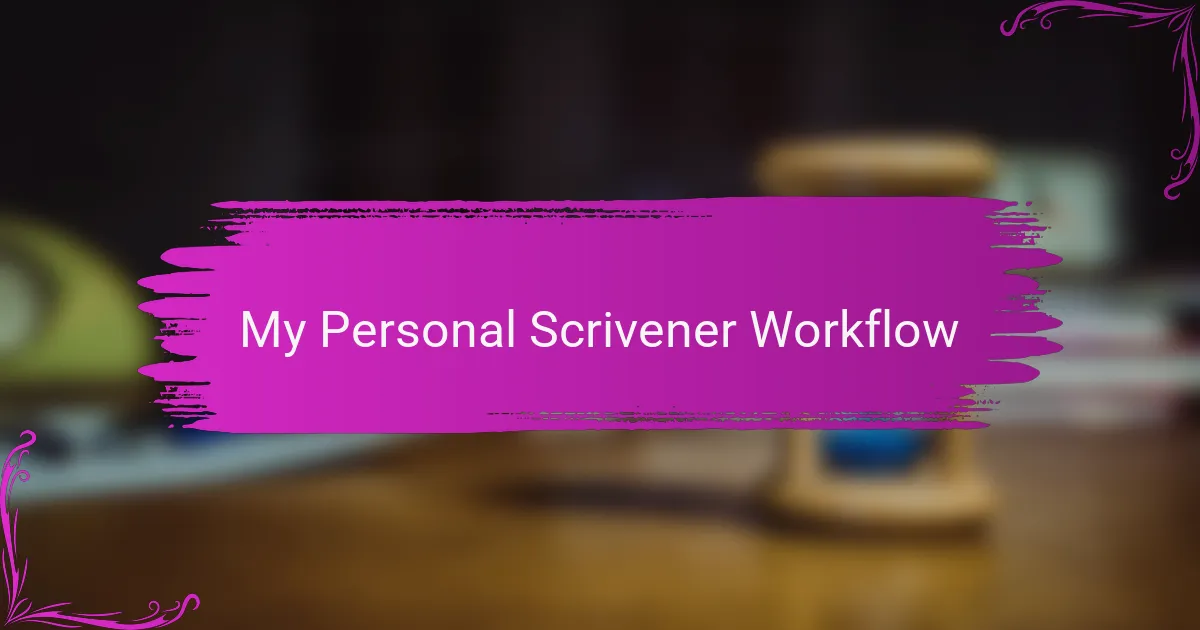
My Personal Scrivener Workflow
My workflow in Scrivener has become a comforting routine that enhances my writing experience. When I start a new project, I immediately create a folder structure that mirrors my outline. This gives me a clear pathway for my thoughts, and I remember the sense of satisfaction it brings when I see everything neatly categorized. It’s like having a roadmap laid out before me, guiding my creativity while keeping the chaos at bay.
One feature that I can’t live without is the split view. It’s a game changer for me when I’m drafting and referencing research. Picture this: I’m writing a pivotal scene while simultaneously glancing at my research notes on the right side of the screen. I often ask myself how I ever managed without this capability—it feels like I’ve found a missing piece in my writing process. This level of multitasking allows ideas to flow more freely, and I’ve noticed my writing sessions are more productive because of it.
I’m also a big fan of setting writing goals within Scrivener. Every time I hit a target, it’s a small victory that keeps my momentum going. I once set a goal to write a thousand words in a session, and achieving it felt exhilarating. I think about how these little milestones keep me anchored in my writing journey, providing motivation when I might otherwise lose focus. How could anyone resist the encouragement of those rewarding numbers, right?
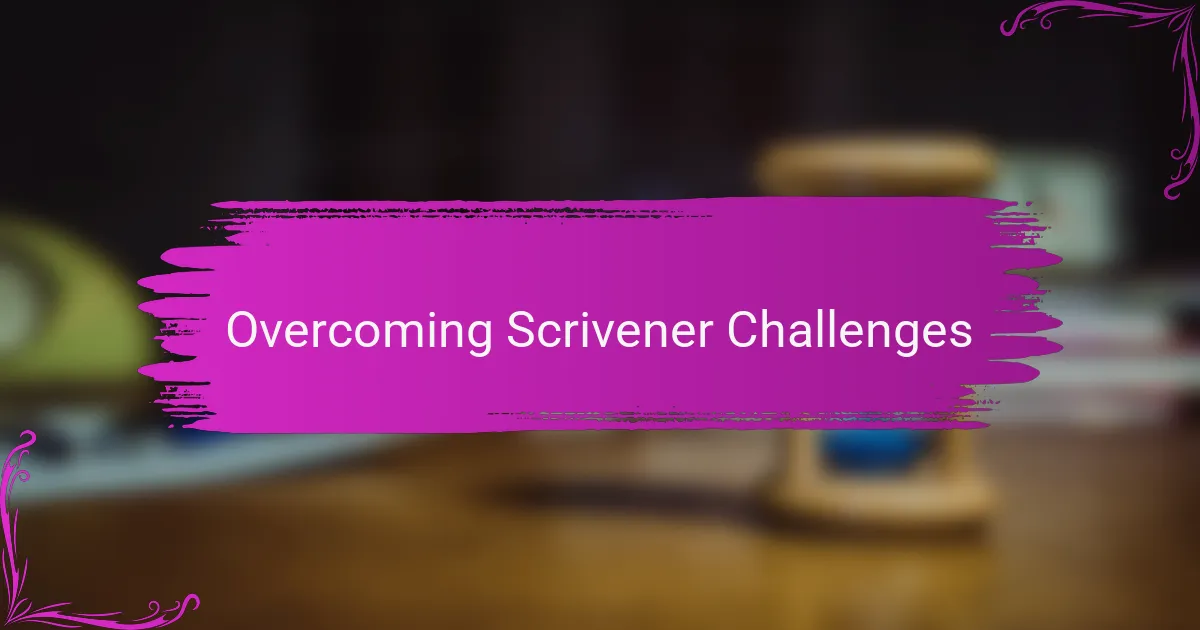
Overcoming Scrivener Challenges
Using Scrivener can be a fantastic experience, but it’s not without its challenges. I remember the first time I opened the software; I was overwhelmed by the myriad of features and options available. It can feel daunting at first, but with a little patience and exploration, I found ways to navigate those early hurdles.
One key challenge is managing the organizational tools effectively. It took me some time to master the binder and document structure, but I eventually realized that breaking my projects into smaller sections made everything more manageable. Here are some tips to help you overcome common Scrivener challenges:
- Familiarize yourself with the interface through tutorials or guides, which can demystify the layout.
- Use the corkboard feature to visually organize your ideas—this has been a game changer for my brainstorming sessions.
- Don’t hesitate to create templates for recurring projects, saving you time on setup.
- Set aside dedicated time to practice and explore features that intrigue you without the pressure of meeting a deadline.
- Keep a dedicated notebook (either physical or digital) for insights and tips you discover along the way.
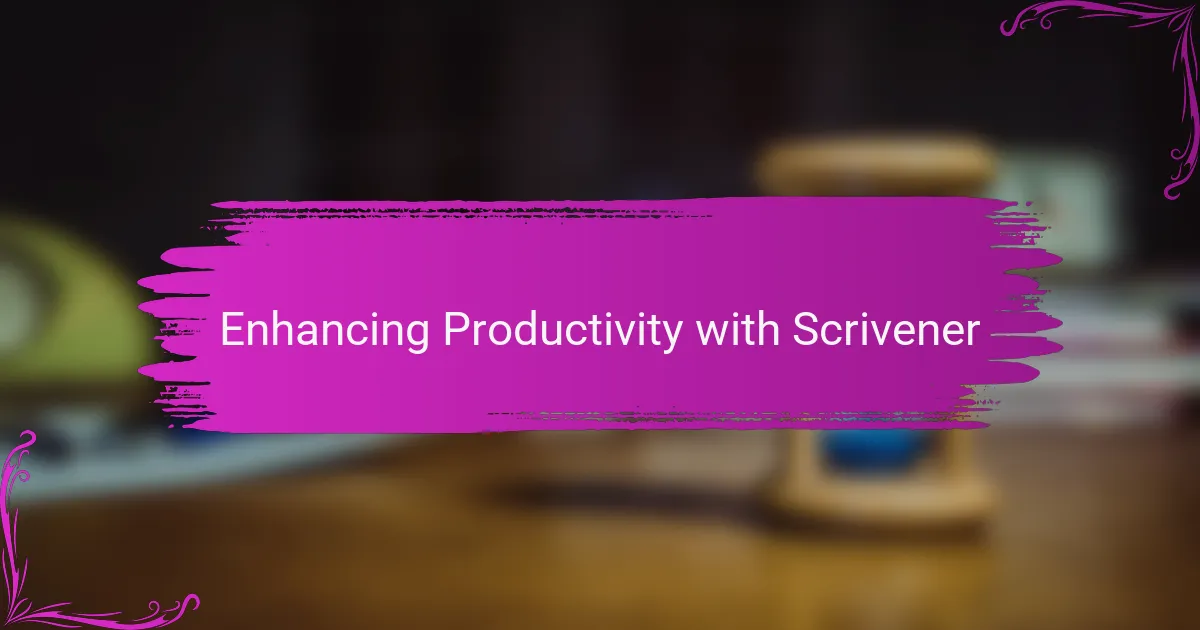
Enhancing Productivity with Scrivener
When it comes to enhancing productivity with Scrivener, I find that its organizational features are a game-changer. The ability to compartmentalize sections of a project helps me maintain focus and clarity. I often use the corkboard feature to visualize my ideas, which keeps my creativity flowing and makes the writing process feel less overwhelming.
Another aspect I appreciate is the ability to set word count targets. This feature encourages me to break down projects into manageable chunks, allowing for steady progress. It’s like having a personal writing coach at my fingertips, gently nudging me to stay on track without the pressure.
Lastly, I love how Scrivener allows me to keep research and notes all in one place. This integration reduces the time I spend searching through endless documents, making my workflow seamless and more enjoyable.
| Scrivener Feature | Benefit |
|---|---|
| Corkboard | Visual organization of ideas |
| Word count targets | Encourages steady progress |
| Research integration | Simplifies workflow |


